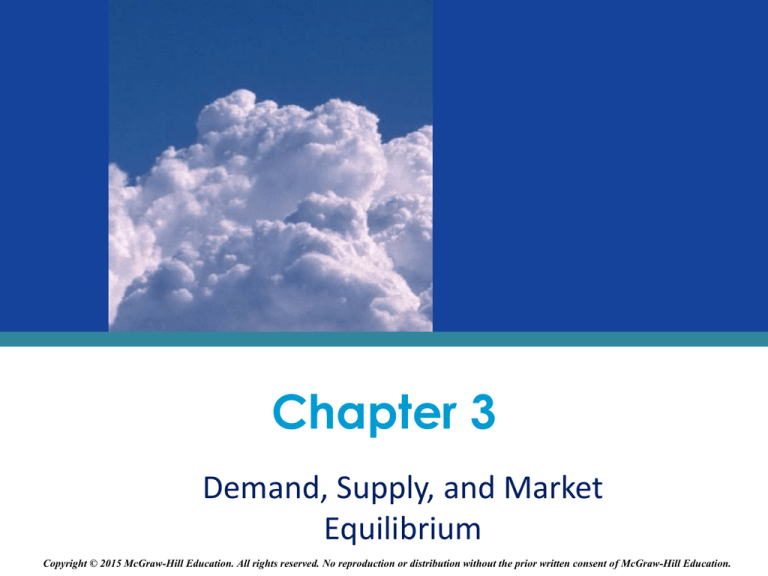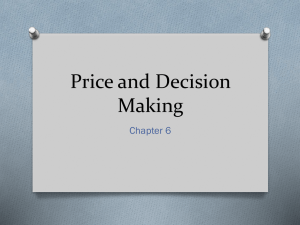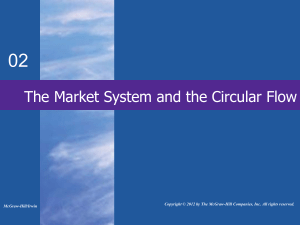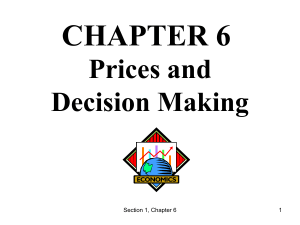
Chapter 3
Demand, Supply, and Market
Equilibrium
Copyright © 2015 McGraw-Hill Education. All rights reserved. No reproduction or distribution without the prior written consent of McGraw-Hill Education.
Markets
• Interaction between buyers and sellers
• Markets may be
• Local
• National
• International
• Price is discovered in the interactions of
buyers and sellers
LO1
3-2
Demand
• Demand
• Demand schedule or demand curve
• Amount consumers are willing and able to
purchase at a given price
• Other things equal
• Individual demand
• Market demand
LO2
3-3
Law of Demand
• Law of demand
• Other things equal, as price falls, the
quantity demanded rises, and as price rises,
the quantity demanded falls
• Explanations
• Price acts as an obstacle to buyers
• Law of diminishing marginal utility
• Income effect and substitution effect
LO2
3-4
Determinants of Demand
•
•
•
•
LO2
Determinants of demand
Change in consumer tastes and preferences
Change in the number of buyers
Change in income
• Normal goods
• Inferior goods
3-5
Determinants of Demand
• Change in prices of related goods
• Complementary good
• Substitute good
• Change in consumer expectations
• Future prices
• Future income
LO2
3-6
Supply
• Supply
• Supply schedule or a supply curve
• Amount producers are willing and able to sell
at a given price
• Individual supply
• Market supply
LO3
3-7
Law of Supply
• Law of supply
• Other things equal, as the price rises, the
quantity supplied rises and as the price falls,
the quantity supplied falls
• Explanation
• Price acts as an incentive to producers
• At some point, costs will rise
LO3
3-8
Determinants of Supply
•
•
•
•
•
•
•
LO3
Determinants of supply
A change in resource prices
A change in technology
A change in the number of sellers
A change in taxes and subsidies
A change in prices of other goods
A change in producer expectations
3-9
Market Equilibrium
• Equilibrium occurs where the demand curve
and supply curve intersect
• Equilibrium price and equilibrium quantity
• Surplus and shortage
• Rationing function of prices
• Efficient allocation
LO4
3-10
Efficient Allocation
• Productive efficiency
• Producing goods in the least costly way
• Using the best technology
• Using the right mix of resources
• Allocative efficiency
• Producing the right mix of goods
• The combination of goods most highly
valued by society
LO4
3-11
Rationing Function of Prices
• The ability of the competitive forces of
demand and supply to establish a price at
which selling and buying decisions are
consistent
LO4
3-12
Changes in Demand and
Equilibrium
D increase:
P, Q
D decrease:
P, Q
P
P
S
S
D2
D3
D1
0
0
Increase in demand
LO5
D4
Decrease in demand
3-13
Changes in Supply and Equilibrium
S increase:
P, Q
S decrease:
P, Q
P
P
S1
S4
S2
D
D
0
0
Increase in supply
LO5
S3
Decrease in supply
3-14
Government Set Prices
• Price ceiling
• Set below equilibrium price
• Rationing problem
• Black markets
• Example is rent control
LO6
3-15
Government Set Prices
• Price floor
• Prices are set above the market price
• Chronic surpluses
• Example is the minimum wage law
LO6
3-16









